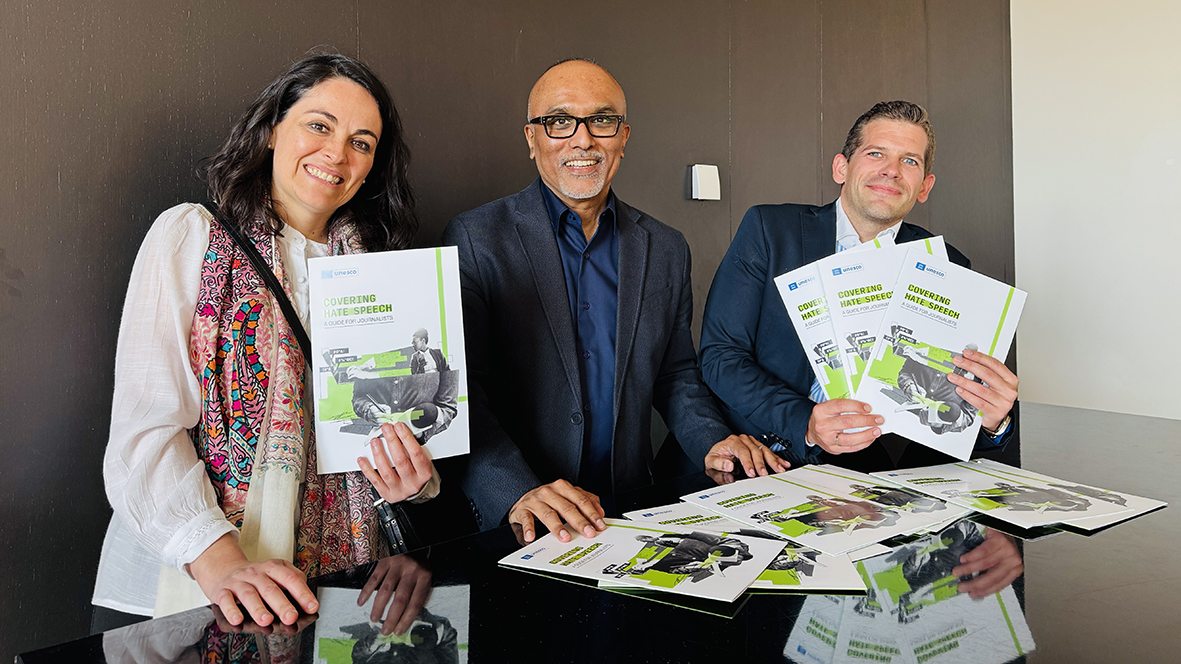Published: 2025-05-12
When the United Nations agency for communication and culture wanted to develop guidance for journalists on covering hate speech, it sought the help of journalism professor, Cherian George. The publication he authored for UNESCO, Covering Hate Speech: A Guide for Journalists, is an example of how Hong Kong Baptist University researchers are making a global impact beyond academia.
The publication was launched at a parallel event at UNESCO’s World Press Freedom Day celebrations in Brussels, Belgium, on 6 May 2025. George introduced a draft last October at the African Investigative Journalism Conference at the University of the Witwatersrand in Johannesburg, South Africa. Given the urgency of this global challenge, UNESCO has also asked him to present the guide at the Global Media Forum organised by Germany’s international broadcaster Deutsche Welle in Bonn in July, and the World Journalism Education Congress in San Francisco in August.
“This publication will serve as a vital resource for journalists and media organisations, enabling them to move beyond traditional reporting and use the power of journalism to combat hate campaigns,” said Ana Cristina Ruelas, a Communication and Information programme specialist with UNESCO (the UN Educational, Scientific and Cultural Organization).
 |
Cherian George with UNESCO’s Ana Cristina Ruelas and Mikel Aguirre Idiaquez in Brussels. |
George has been researching hate speech and its relationship with free speech for around 15 years. His 2016 book, Hate Spin: The Manufacture of Religious Offense and its Threat to Democracy (MIT Press) was named by Publishers’ Weekly as one of the best 100 books of the year.
“I have been pushing for a paradigmatic shift in how we understand hate speech,” George said. “Conventionally, most media reports as well as academic research fixate on the message level. They try to identify, debate, and regulate extreme and shocking utterances. This approach fails to grasp how hate propaganda actually works.”
In Hate Spin, George showed how hate campaigns in India, Indonesia, and the United States involve multiple actors using layered messages over long periods. Most of their expressions are subtle and coded and do not sound shocking or extreme. Agents of hate often play the victim, so as not to seem like aggressors.
“The most effective hate propaganda does not use a lot of conventional hate speech. This is one reason why hate speech law is inadequate”, said George, who this year also wrote a critical analysis of Asian hate speech law for the forthcoming Oxford Handbook on Hate Speech. Hate must be countered through a broader societal response, including by media applying their professional ethics.
“UNESCO’s invitation was an opportunity for me to translate my research into guidelines for media,” he said. In the guide, George argues that professional journalism already possesses relevant capacities for dealing with hate and intolerance. Journalists can draw from their existing codes of ethics — which provide guidelines on accuracy, stereotyping, covering vulnerable communities, and reporting online opinion, for example.
George also calls on media to learn from how the best investigative journalists cover systemic problems such as corruption, trafficking, and environmental pollution — not as single acts but as processes and systems. “Hate campaigns need to be reported in the same way”, he says.
Sri Lankan journalist Arun Arokianathan welcomed the new publication, saying that its framing of hate speech as “a process rather than a one-off event” resonated with his own experience covering politics in his country for over two decades. “I’ve seen firsthand how hate isn’t just expressed — it’s manufactured, cultivated, and weaponized for political gain,” he said.
“What’s been missing in much of the mainstream coverage is precisely what [the guide is] advocating: a systems-based approach. Who benefits? Who is orchestrating the narrative? Which media outlets serve as the echo chambers? And what roles do intelligence services and surveillance infrastructure play in either enabling or ignoring the spread of this hate?” Arokianathan added. “When we covered corruption in the early 2000s, we knew we had to follow the money. Today, when we cover hate, we must follow the networks: digital, political, and ideological. This kind of framing can really push journalism in the right direction.”
UNESCO’s Ruelas said that George’s framework, emphasising the “multi-actor, multi-layered character of hate propaganda”, has “significantly shaped our approach to media development and training programmes”. “This will help further highlight the necessity for the global media development community to adopt a more comprehensive approach to covering hate speech that recognises the broader social and political dynamics at play,” she added.
UNESCO has already translated the guide into Indonesian. Other language versions will follow. It is freely downloadable from the UN’s digital library.